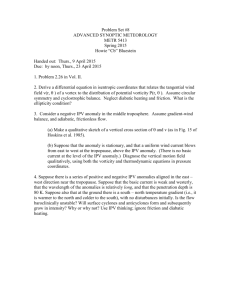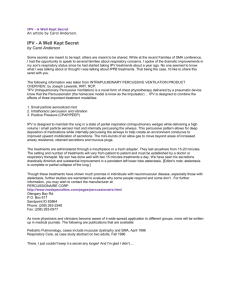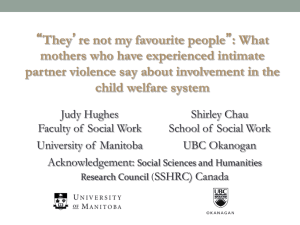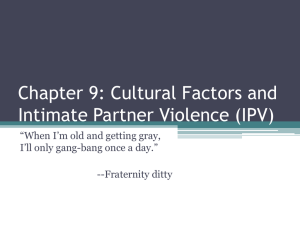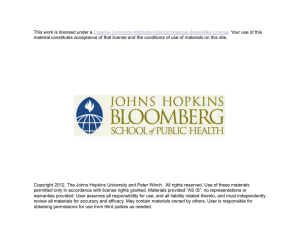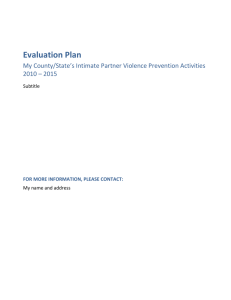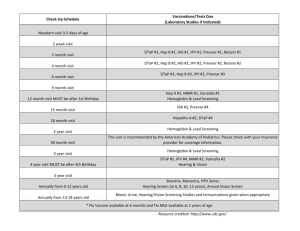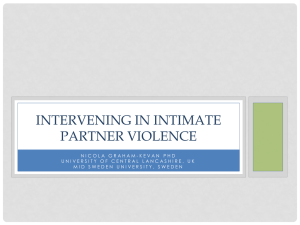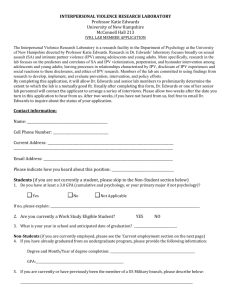Document 13583697
advertisement
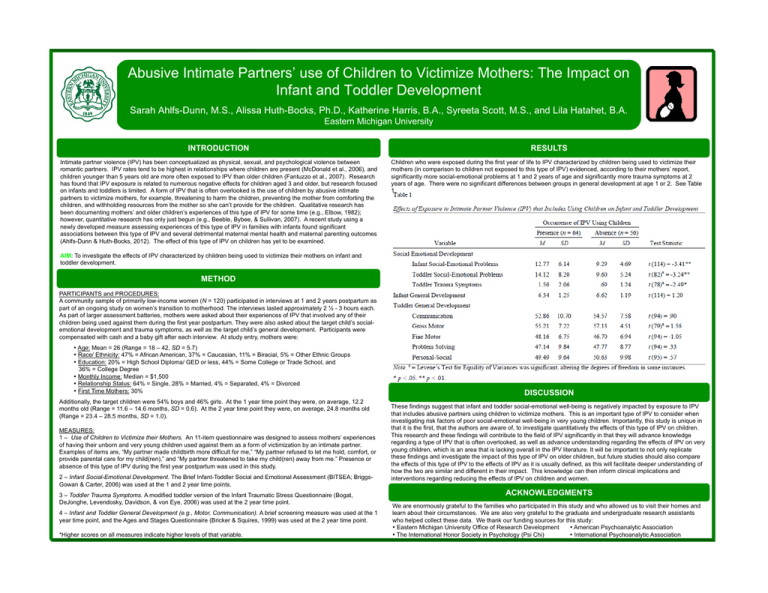
Abusive Intimate Partners’ use of Children to Victimize Mothers: The Impact on Infant and Toddler Development Sarah Ahlfs-Dunn, M.S., Alissa Huth-Bocks, Ph.D., Katherine Harris, B.A., Syreeta Scott, M.S., and Lila Hatahet, B.A. Eastern Michigan University INTRODUCTION Intimate partner violence (IPV) has been conceptualized as physical, sexual, and psychological violence between romantic partners. IPV rates tend to be highest in relationships where children are present (McDonald et al., 2006), and children younger than 5 years old are more often exposed to IPV than older children (Fantuzzo et al., 2007). Research has found that IPV exposure is related to numerous negative effects for children aged 3 and older, but research focused on infants and toddlers is limited. A form of IPV that is often overlooked is the use of children by abusive intimate partners to victimize mothers, for example, threatening to harm the children, preventing the mother from comforting the children, and withholding resources from the mother so she can’t provide for the children. Qualitative research has been documenting mothers’ and older children’s experiences of this type of IPV for some time (e.g., Elbow, 1982); however, quantitative research has only just begun (e.g., Beeble, Bybee, & Sullivan, 2007). A recent study using a newly developed measure assessing experiences of this type of IPV in families with infants found significant associations between this type of IPV and several detrimental maternal mental health and maternal parenting outcomes (Ahlfs-Dunn & Huth-Bocks, 2012). The effect of this type of IPV on children has yet to be examined. RESULTS Children who were exposed during the first year of life to IPV characterized by children being used to victimize their mothers (in comparison to children not exposed to this type of IPV) evidenced, according to their mothers’ report, significantly more social-emotional problems at 1 and 2 years of age and significantly more trauma symptoms at 2 years of age. There were no significant differences between groups in general development at age 1 or 2. See Table 1. AIM: To investigate the effects of IPV characterized by children being used to victimize their mothers on infant and toddler development. METHOD PARTICIPANTS and PROCEDURES: A community sample of primarily low-income women (N = 120) participated in interviews at 1 and 2 years postpartum as part of an ongoing study on women’s transition to motherhood. The interviews lasted approximately 2 ½ - 3 hours each. As part of larger assessment batteries, mothers were asked about their experiences of IPV that involved any of their children being used against them during the first year postpartum. They were also asked about the target child’s socialemotional development and trauma symptoms, as well as the target child’s general development. Participants were compensated with cash and a baby gift after each interview. At study entry, mothers were: • Age: Mean = 26 (Range = 18 – 42, SD = 5.7) • Race/ Ethnicity: 47% = African American, 37% = Caucasian, 11% = Biracial, 5% = Other Ethnic Groups • Education: 20% = High School Diploma/ GED or less, 44% = Some College or Trade School, and 36% = College Degree • Monthly Income: Median = $1,500 • Relationship Status: 64% = Single, 28% = Married, 4% = Separated, 4% = Divorced • First Time Mothers: 30% Additionally, the target children were 54% boys and 46% girls. At the 1 year time point they were, on average, 12.2 months old (Range = 11.6 – 14.6 months, SD = 0.6). At the 2 year time point they were, on average, 24.8 months old (Range = 23.4 – 28.5 months, SD = 1.0). MEASURES: 1 – Use of Children to Victimize their Mothers. An 11-item questionnaire was designed to assess mothers’ experiences of having their unborn and very young children used against them as a form of victimization by an intimate partner. Examples of items are, “My partner made childbirth more difficult for me,” “My partner refused to let me hold, comfort, or provide parental care for my child(ren),” and “My partner threatened to take my child(ren) away from me.” Presence or absence of this type of IPV during the first year postpartum was used in this study. 2 – Infant Social-Emotional Development. The Brief Infant-Toddler Social and Emotional Assessment (BITSEA; BriggsGowan & Carter, 2006) was used at the 1 and 2 year time points. 3 – Toddler Trauma Symptoms. A modified toddler version of the Infant Traumatic Stress Questionnaire (Bogat, DeJonghe, Levendosky, Davidson, & von Eye, 2006) was used at the 2 year time point. 4 – Infant and Toddler General Development (e.g., Motor, Communication). A brief screening measure was used at the 1 year time point, and the Ages and Stages Questionnaire (Bricker & Squires, 1999) was used at the 2 year time point. *Higher scores on all measures indicate higher levels of that variable. DISCUSSION These findings suggest that infant and toddler social-emotional well-being is negatively impacted by exposure to IPV that includes abusive partners using children to victimize mothers. This is an important type of IPV to consider when investigating risk factors of poor social-emotional well-being in very young children. Importantly, this study is unique in that it is the first, that the authors are aware of, to investigate quantitatively the effects of this type of IPV on children. This research and these findings will contribute to the field of IPV significantly in that they will advance knowledge regarding a type of IPV that is often overlooked, as well as advance understanding regarding the effects of IPV on very young children, which is an area that is lacking overall in the IPV literature. It will be important to not only replicate these findings and investigate the impact of this type of IPV on older children, but future studies should also compare the effects of this type of IPV to the effects of IPV as it is usually defined, as this will facilitate deeper understanding of how the two are similar and different in their impact. This knowledge can then inform clinical implications and interventions regarding reducing the effects of IPV on children and women. ACKNOWLEDGMENTS We are enormously grateful to the families who participated in this study and who allowed us to visit their homes and learn about their circumstances. We are also very grateful to the graduate and undergraduate research assistants who helped collect these data. We thank our funding sources for this study: • Eastern Michigan University Office of Research Development • American Psychoanalytic Association • The International Honor Society in Psychology (Psi Chi) • International Psychoanalytic Association
